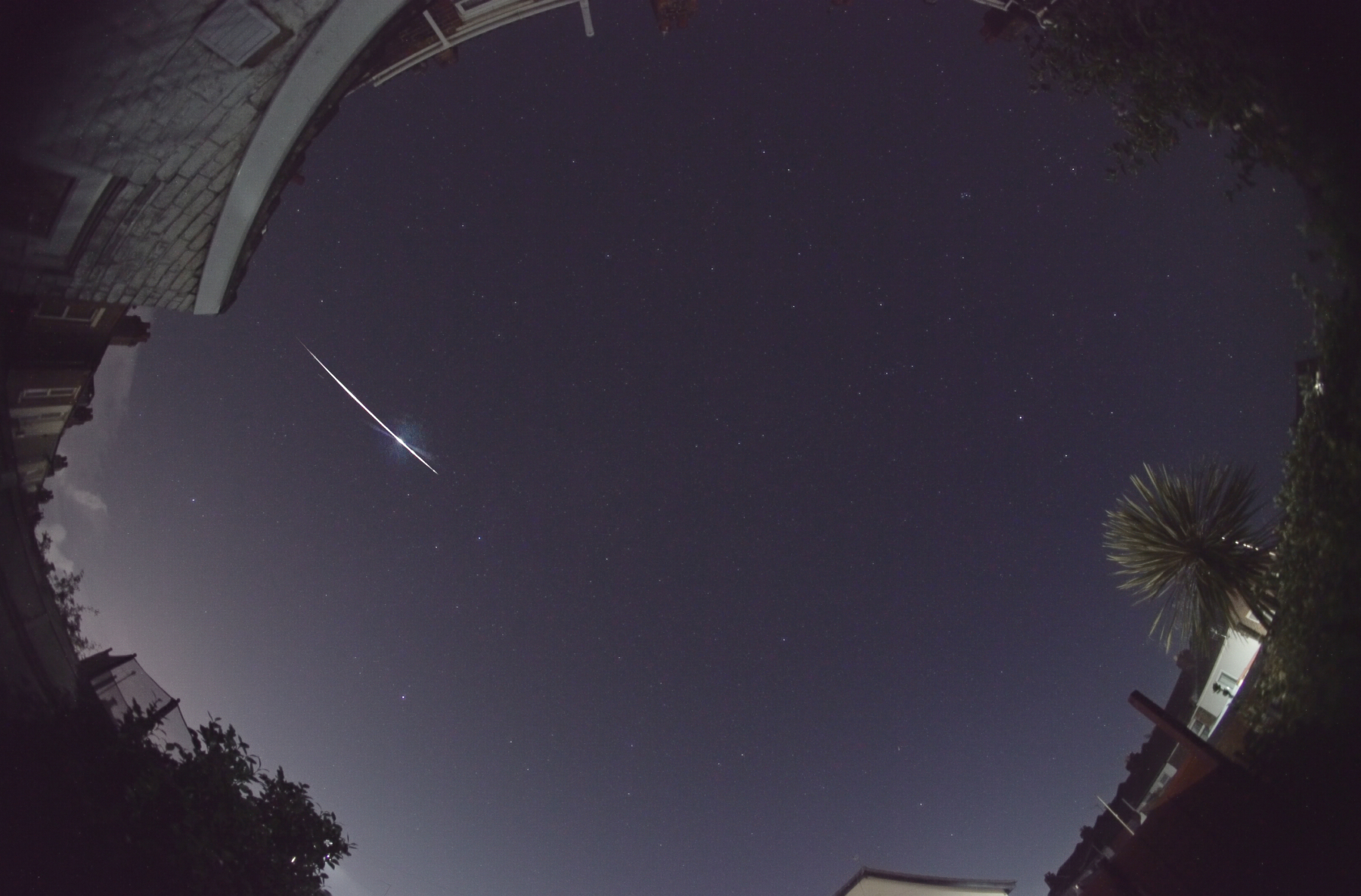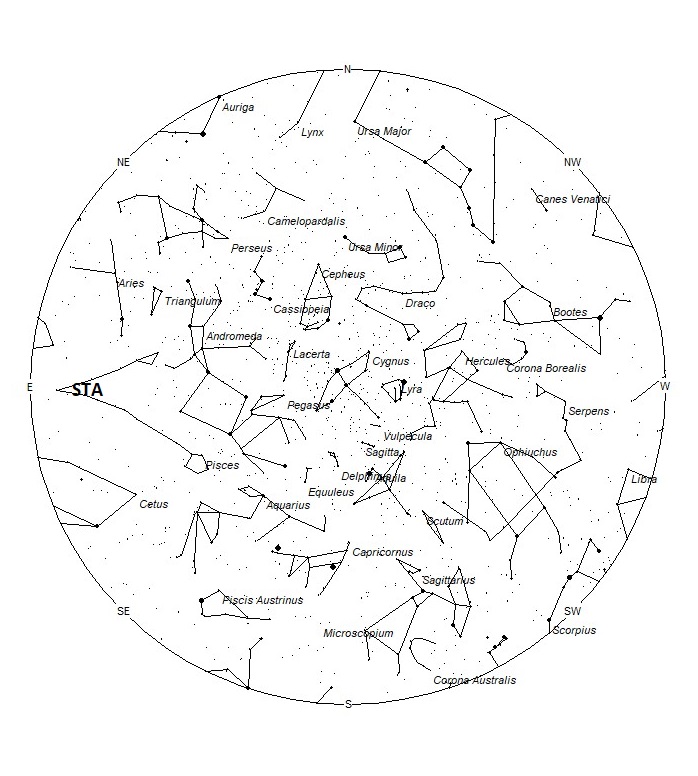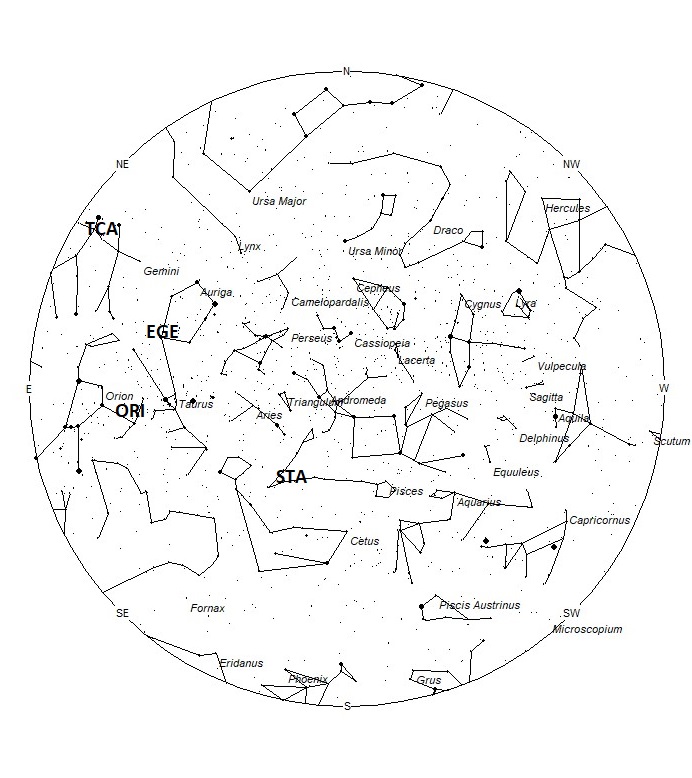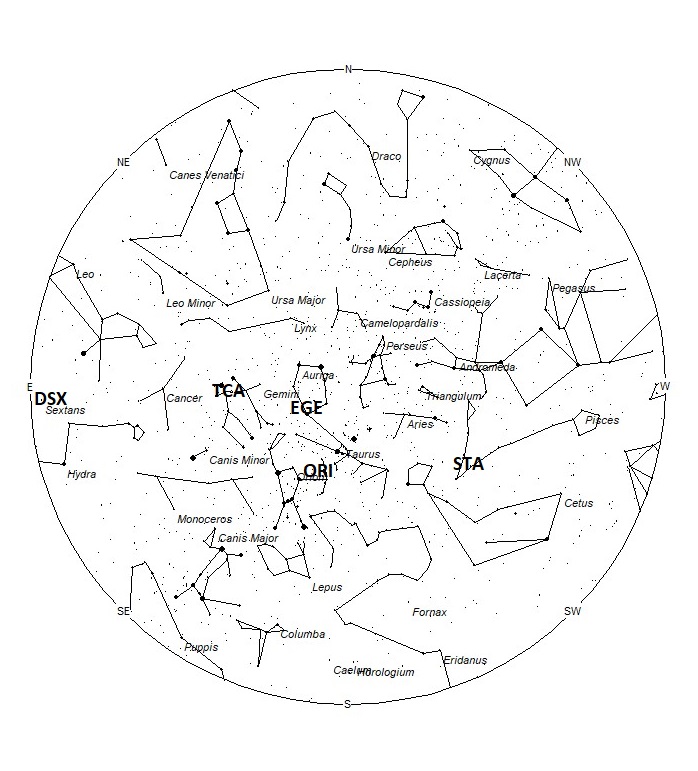
During this period, the moon reaches its last quarter phase on Tuesday September 28th. At that time the moon lies 90 degrees west of the sun and rises near 23:00 local daylight saving time (LDST). This weekend the waning gibbous moon will rise during the late evening hours and will interfere with meteor observing the remainder of the night. The estimated total hourly meteor rates for evening observers this week is near 4 as seen from mid-northern latitudes (45N) and 3 as seen from tropical southern locations (25S). For morning observers, the estimated total hourly rates should be near 9 as seen from mid-northern latitudes (45N) and 7 as seen from tropical southern locations (25S). The actual rates will also depend on factors such as personal light and motion perception, local weather conditions, alertness, and experience in watching meteor activity. Morning rates are reduced due to moonlight. Note that the hourly rates listed below are estimates as viewed from dark sky sites away from urban light sources. Observers viewing from urban areas will see less activity as only the brighter meteors will be visible from such locations.
The radiant (the area of the sky where meteors appear to shoot from) positions and rates listed below are exact for Saturday night/Sunday morning September 25/26. These positions do not change greatly day to day so the listed coordinates may be used during this entire period. Most star atlases (available at science stores and planetariums) will provide maps with grid lines of the celestial coordinates so that you may find out exactly where these positions are located in the sky. I have also included charts of the sky that display the radiant positions for evening, midnight, and morning. The center of each chart is the sky directly overhead at the appropriate hour. These charts are oriented for facing south but can be used for any direction by rotating the charts to the desired direction. A planisphere or computer planetarium program is also useful in showing the sky at any time of night on any date of the year. Activity from each radiant is best seen when it is positioned highest in the sky, either due north or south along the meridian, depending on your latitude. It must be remembered that meteor activity is rarely seen at the radiant position. Rather they shoot outwards from the radiant, so it is best to center your field of view so that the radiant lies at the edge and not the center. Viewing there will allow you to easily trace the path of each meteor back to the radiant (if it is a shower member) or in another direction if it is sporadic. Meteor activity is not seen from radiants that are located far below the horizon. The positions below are listed in a west to east manner in order of right ascension (celestial longitude). The positions listed first are located further west therefore are accessible earlier in the night while those listed further down the list rise later in the night.
These sources of meteoric activity are expected to be active this week.
.
The Southern Taurids (STA) are very complex but recent investigations have revealed two clearly distinct components. The first component represents the early and regular annual activity of Southern Taurids, and the latter component represents the main source of activity and is periodic. The early STA’s are active from September 28 through November 7 and peaks on October 16th. The main component of the STA’s are active from October 13 through December 2 and peaks on November 4*. The center of the large STA radiant is currently (Sep 28) located at 01:40 (025) +06. This position lies in southeastern Pisces, just north of the 4th magnitude star known as nu Piscium. This radiant is best placed near 0200 LDST, when it lies on the meridian and is located highest in the sky. Rates at this time should be near 2 per hour no matter your location. With an entry velocity of 31 km/sec., the average STA meteor would be of medium-slow velocity.
*The activity of meteor showers recorded by SonotaCo Net video observations 2007–2018, Masahiro Koseki, 2021, https://www.meteornews.net/2021/02/09/february-2021-special-issue-of-emeteornews-online/ Page 170
The Orionids (ORI) become active this week, but rates will remain very low until mid-October. The Orionids are active from September 26 though November 22, with maximum activity occurring on October 21. The radiant is currently located at 05:06 (077) +13, which places it in northwestern Orion, 2 degrees east of the 4th magnitude star known as omicron2 Orionis. This area of the sky is best placed for observing near 5:00 LDST. Current rates are expected to be less than 1 per hour, no matter your location. With an entry velocity of 68 km/sec., the average ORI meteor would be of swift velocity.
The first members of the epsilon Geminids (EGE) are expected to be seen this week from a radiant located at 05:26 (082) +30. This area of the sky lies in southern Auriga, only 1 degree north of the 2nd magnitude star known as El Nath (beta Tauri). This area of the sky is best placed during the last dark hour prior to dawn. These meteors are active from September 27 through November 8, with maximum activity occurring on October 18. Since maximum is still three weeks away, rates at this time should be less than 1 per hour no matter your location. With an entry velocity of 70 km/sec., the average EGE meteor would be of swift velocity.
The tau Cancrids (TCA) are a weak shower with a long activity period of seven weeks. They are active from September 23 through November 12 with maximum activity occurring on October 22. The radiant currently lies at 07:41 (115) +29, which places it in northeastern Gemini, only 2 degrees northwest of the 1st magnitude star known as Pollux (beta Geminiorum). This area of the sky is best placed during the last dark hour prior to dawn.Expected hourly rates are less than 1 per hour no matter your location. With an entry velocity of 67 km/sec., the average TCA meteor would be of swift velocity.
The Daytime Sextantids (DSX) are active from September 22-October 13, with maximum activity occurring on October 3. The current position of the radiant is 10:00 (150) -01. This position lies in central Sextans, 1 degree west of the 4th magnitude star known as alpha Sextantis. This radiant is best placed near 0100 LST, when it lies on the meridian and is located highest in the sky. Rates at this time should be less than 1 per hour no matter your location. With an entry velocity of 33 km/sec., the average DSX meteor would be of medium-slow velocity. No matter your location, these meteors are difficult to observe as the radiant lies roughly 30 degrees from the sun. Therefore, these meteors may only be seen during the last hour prior to dawn, shooting upward from the eastern horizon.
Note: There is the possibility of meteor activity produced by comet 15P/Finlay this upcoming week. The first chance occurs on September 27 between the hours of 13:58 and 16:22 Universal Time. Australia and New Zealand are best placed to view this activity with west Australia having the highest radiant altitude during the evening hours of September 27. The radiant is expected to be located at 17:24 (261) -61, which is located on the Ara/Triangulum Australe border, 5 degrees northeast of the 3rd magnitude star known as beta Trianguli Australis. The second chance for activity occurs on September 29 between the hours of 2:30 and 4:17 and near 7:20 Universal Time. This timing favors the remote areas of the Southern Pacific Ocean between Chile and New Zealand. The radiant is predicted to lie 4 degrees further north on the borders of Ara and Norma. Any activity from this source is expected to be faint and very slow. Zenith hourly rates are predicted to be 5-20 for September 27 and 50-120 for September 29.*
*2021 IMO Meteor Shower Calendar by Jürgen Rendtel. Page 10
As seen from the mid-northern hemisphere (45N) one would expect to see approximately 7 sporadic meteors per hour during the last hour before dawn as seen from rural observing sites. Evening rates would be near 3 per hour. As seen from the tropical southern latitudes (25S), morning rates would be near 5 per hour as seen from rural observing sites and 2 per hour during the evening hours. Locations between these two extremes would see activity between the listed figures. Morning rates are reduced due to interfering moonlight.
|
SHOWER |
DATE OF MAXIMUM ACTIVITY | CELESTIAL POSITION | ENTRY VELOCITY | CULMINATION | HOURLY RATE | CLASS |
| RA (RA in Deg.) DEC | Km/Sec | Local Daylight Saving Time | North-South | |||
| Southern Taurids (STA) | Oct 16 | 01:40 (025) +06 | 31 | 02:00 | 2 – 2 | II |
| Orionids (ORI) | Oct 21 | 05:06 (077) +13 | 68 | 05:00 | <1 – <1 | I |
| epsilon Geminids (EGE) | Oct 18 | 05:26 (082) +30 | 70 | 06:00 | <1 – <1 | II |
| tau Cancrids (TCA) | Oct 22 | 07:41 (115) +29 | 67 | 08:00 | <1 – <1 | IV |
| Daytime Sextantids (DSX) | Oct 03 | 10:00 (150) -01 | 33 | 10:00 | <1 – <1 | IV |
 American Meteor Society
American Meteor Society



Hi, I believe I witnessed a meteor last night 25/9/21 at approximately 1030pm , location Palmerston North NZ, It was overcast night but there was a large flash in the sky followed with a loud boom, I originally thought it was lightning but due to the single boom (much like a sonic boom) and because there was no roll or clap that thunder usually has made me assume that it was a meteor breaking the atmosphere, The flash occurred in the sky approximately 15-20km north of my location (Bulls area).
12/01/2021 (Brescia, Italy) at 6:15 AM, I saw a very distant southward light that seemed to descend perpendicularly to the ground
Southern Alabama, approximately 1030PM 09/30/2021. Largest object I’ve ever seen, judging by time spent burning in atmosphere. Left a contrail, which I found unusual. Tracked it across my entire possible field of vision, was still burning as it crossed the horizon. Very bright, flame colored trail. For (a slightly subjective sense of) scale, the trail was slightly too long to completely cover up by lifting my finger up across it.
I watched it for over 90 seconds and it never appeared to lose any mass, or at least not enough to affect its burn.
Best I’ve ever seen.
I saw the same thing from Savannah Georgia at the same time! Maybe closer to 10:45